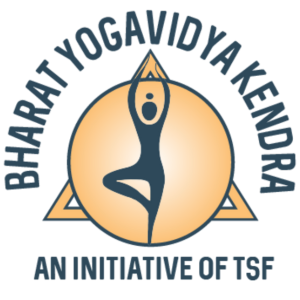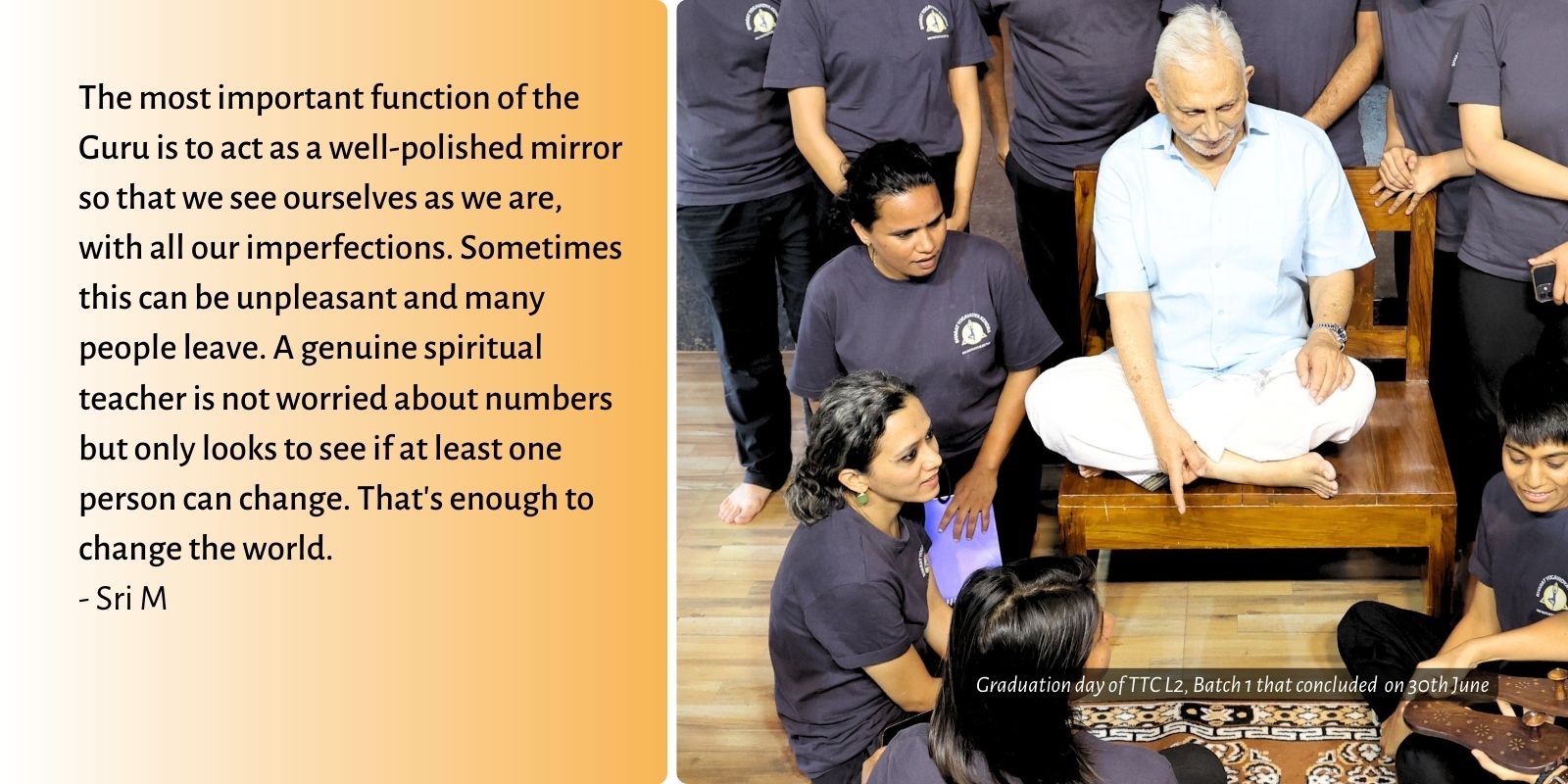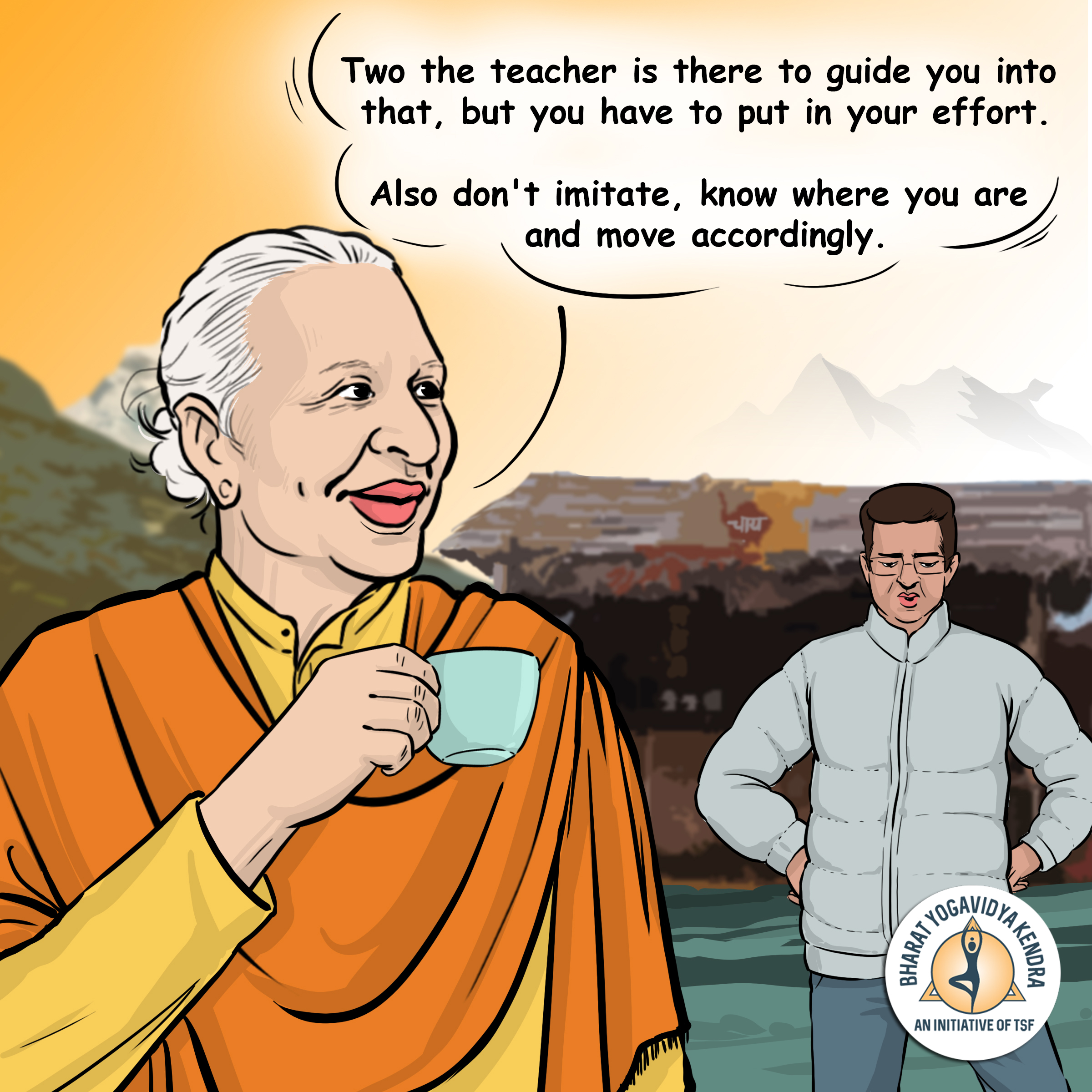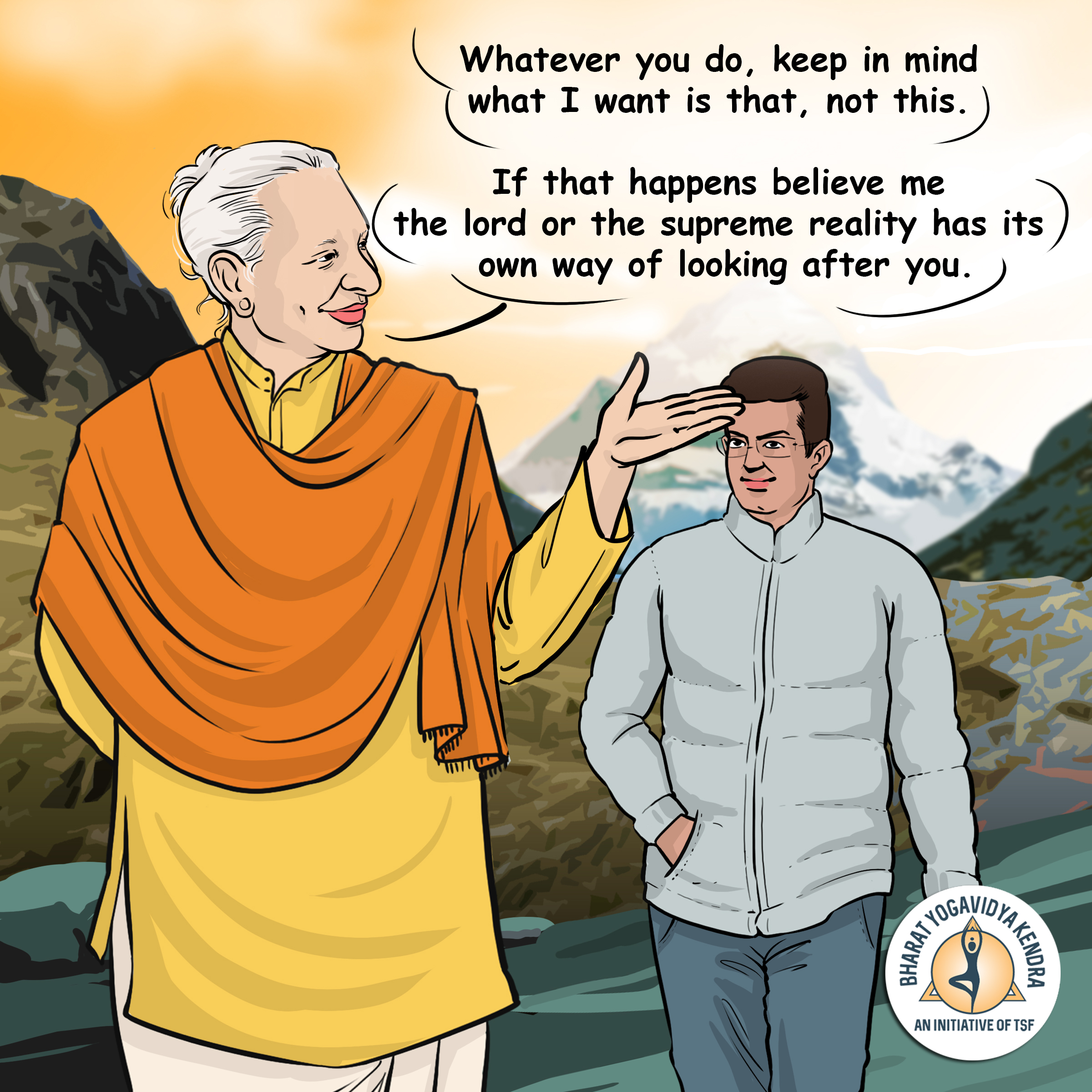Guru Purnima:
The Essence of Spiritual Guidance
Welcome to the July edition of Yogavidya! This month, we celebrate Guru Purnima, a time to honor and show gratitude to our teachers/gurus. It’s an opportunity to reflect on the impact that their wisdom & guidance have on our spiritual journeys.
Guru Purnima falls on the full moon day in the Hindu month of Ashadha. During Ashadha, the winds are strong, keeping the clouds moving and revealing the full moon. These clouds represent the ignorance and confusion in our minds, while the full moon symbolizes the guru, who clears away this confusion & shines light on our path.
The word “guru” means “one who dispels the darkness of ignorance.” Just like the moon reflects the light of the sun, a guru reflects the supreme consciousness, giving us glimpses of higher wisdom and spiritual truth. While we can’t look directly at the sun, we can enjoy the gentle, reflective light of the moon. Similarly, a guru makes the wisdom of the universe accessible and understandable.
One of the fundamental teachings of yoga is the importance of the guru-student relationship. This bond is built on trust, respect, and a mutual commitment to growth.
The guru imparts not just knowledge but also the experiential wisdom that can transform our lives. This month, we meditate on this sacred relationship, exploring stories of renowned gurus, their teachings, and the timeless wisdom they offer.
In celebrating Guru Purnima, we acknowledge that spiritual guidance is not confined to a single day or a physical form. It is a continuous, evolving relationship that nurtures our growth. By honoring our gurus, we honor the journey itself – a path filled with learning, transformation, and endless possibilities.
May this edition of Yogavidya inspire you to reflect on the gurus in your life and the invaluable wisdom they impart.
With gratitude, The BYK Team
Teachings are more important than the teacher!
Sri M Explains
In this insightful video, Sri M shares an important message: “the teachings are more important than the teacher.” He explains that while it’s common to develop a habit of worshipping the teacher, what’s truly important is to focus on the lessons they impart. Sri M encourages us to actively work on and apply these teachings in our lives, rather than just admiring the person who teaches them. This video is a thoughtful reminder that our spiritual growth comes from practicing what we learn. Tune in to gain valuable insights and inspiration from Sri M’s wisdom.
Talk with M
BLOG POST
Guru an Ocean of Wisdom
The importance of a Guru has been explained in the 17th Chapter of Shri Sai Sat Charita by Hemadpant. One should regularly listen to the excellent scriptures, abide by the words of the Guru while remaining alert all the time and should choose his way to salvation without losing the sight of it. From the doctrines of the Guru, a large number of devotees reach the level of salvation and their path to emancipation gets easier.
A true guru is one who has realized his identity with the omnipresent Spirit. Such a person is uniquely qualified to lead the seeker on his or her inward journey.
A real physical Guru is recognised by two things:
- First by the message he gives, and
- Second by the level of responsibility he takes of your spiritual growth.
The great saint Kabir in one of his couplets says :
Guru ke sumiran maatr se, nasht vighn anantTaase sarv aarambh me(i), Dhyaavat hai sab sant
Just by remembering your Guru, you will be able to overcome all the obstacles. Hence, the Guru is remembered at the beginning of any task by one and all.
Read the full article here>>>
Did You Know
You many know that Buddha’s first teaching at Sarnath is also celebrated as Guru Purnima, but do you know what they are?
The Dhammacakkappavattana Sutta, or “Setting the Wheel of Dharma in Motion,” laid the foundation for his teachings. Delivered to his first five disciples, this sermon introduced the Four Noble Truths and the Noble Eightfold Path. The four noble truths are :
- The Truth of Suffering: Life involves suffering and dissatisfaction.
- The Truth of the Cause of Suffering: Desire and attachment are the root causes of suffering.
- The Truth of the End of Suffering: It is possible to end suffering
- The Truth of the Path to End Suffering: The Noble Eightfold Path leads to the cessation of suffering.
Guru Purnima is a day to reflect on these profound teachings and honor all teachers who guide us on our spiritual journeys.
BOOK REVIEW
Sacred Bonds: The Guru-Disciple Dynamic

Light on the Guru and Disciple Relationship by Swami Satyasangananda Saraswati is like a breath of fresh air in the world of spiritual literature. This inspiring book takes you on a journey into the heart of the guru-disciple tradition, guided by the wisdom of a remarkable female monk and disciple of the renowned Swami Satyananda Saraswati of the Bihar School of Yoga.
In a field often dominated by male perspectives, her insights offer a unique vibrant take on this timeless tradition. The book is thoughtfully divided into two parts. The first part, penned by Swami Satyasangananda herself, is a treasure trove of practical wisdom. She talks about the necessity of a guru, how to find and recognize one, and the different types of gurus and disciples. She doesn’t shy away from addressing the challenges and misconceptions either, offering real-world advice on dealing with negativity and the ever-present ego.
One of the standout aspects of this book is her discussion on the inner guru. Swami Satyasangananda acknowledges that while the real guru resides within us, it can be incredibly challenging to hear and follow this inner guide amidst the noise of our ego and desires.
The second part of the book is like a spiritual retreat in itself. It features satsangs and talks by Swami Satyananda, rich with wisdom on topics like the role of the guru, surrendering the ego, and the power of faith and devotion. These teachings complement Swami Satyasangananda’s writing beautifully, providing a deeper connection to the guru-disciple relationship.
PRANAYAMA GUIDE
Chandrabhedi Pranayama
Chandra means moon, and Bhedan means piercing, this pranayama is also known as left nostril breathing which focuses on calming the mind, cooling the body and activating the lunar channel ( left side) which is considered conducive for practising dharana and dhyana when activated.

Practice Steps
- Sit in a comfortable position with your spine straight.
- Adopt Nasika mudra folding the index and middle finger of the right hand and close your right nostril with your right thumb.
- Inhale slowly and deeply through your left nostril.
- Close your left nostril with your right ring finger, and then exhale through your right nostril.Repeat this cycle for 5-10 minutes.
Benefits
- Decreases body temperature and reduces body heat.
- It effectively brings down the heart rate and lowers blood pressure.
- Cooling the body alleviates issues like acidity, heartburn and belching.
- Stimulates the parasympathetic nervous system reducing stress & anxiety.
- Helps with better concentration during meditation and sadhana.
Contraindications
- Avoid if you have respiratory conditions such as a cold or sinus congestion etc.
- Avoid practicing in extremely cold climate.
- Low BP conditions consult a physician before doing the practice.
Alumni Creative Showcase

About the Artist: Shubhangi K. Bhide is an education professional with over 15 years of experience in science teaching, research, and mentoring. Passionate about making learning meaningful and effective, she has recently focused on Social and Emotional Wellbeing, believing Yoga to be a key path to holistic health. Working with NGOs has further deepened her interest. Though her love for drawing and painting was sidelined for years, a recent art session at TTC reignited her passion, inspiring her to express her feelings through art once again.
YOGA RESOURCE
Visualize your Guru
Join us for a guided meditation on visualizing the guru. This session is designed to help you connect deeply with your spiritual guide. Through focused breathing and vivid imagery, you’ll learn to feel the presence of your guru, gain insights, and strengthen your spiritual bond. This meditation aims to enhance your clarity, intuition, and overall spiritual growth.
Journal Prompts
Use the below prompts to write and reflect on this month’s theme:
- Reflect on a significant teacher or mentor in your life.
- How do you connect with your inner guru?
- What recent teachings have resonated with you, and how are you applying them?
- Write about a moment of gratitude for guidance or support.
- What is the role of a guru or mentor in your life?
- Reflect on a challenge that taught you an important lesson.
- What spiritual questions are you currently seeking answers to?
- What qualities do you admire in a teacher, and how can you cultivate them?
- How do you practice surrender and trust on your spiritual journey?
- Reflect on how you engage in selfless service (seva).
Ayurvedic Wisdom
Ashada Month
Ashada month marks the onset of Varsha Ritu (monsoon), bringing environmental changes that impact dosha balance. The Increased humidity weakens digestive fire (agni). Thus the cool, damp weather can aggravate Vata, while residual Pitta from summer persists.
Dietary Recommendations
- Warm Foods: Favor warm, easily digestible, and lightly spiced foods.
- Avoid: Raw foods, cold drinks, and heavy, oily meals.
- Spices: Use ginger, cumin, and black pepper to aid digestion.
Lifestyle Adjustments
Stay active to prevent the stagnation of fluids in the body, which can lead to Kapha-related issues like colds and congestion. Stay warm and avoid getting wet in the rain.
Q&A Corner
Q: I want to celebrate Guru Purnima, but I don’t have or believe in a personal guru. How can I still honor this day?
A: Reflect on your personal growth and sources of wisdom, express gratitude to all mentors in your life, participate in community service, and dedicate your yoga or meditation practice to the principles of guidance and learning.
Q: I have learned yoga but keep procrastinating my practice. What can I practically do to help myself?
A: To overcome procrastination and build a consistent yoga practice, start by breaking your sessions into short, manageable time frames, like 10-15 minutes. This can help trigger dopamine release, making the task feel more rewarding. Set a regular practice time and create a dedicated, serene space to make yoga more inviting. Reward yourself after each session to reinforce positive behavior, and try to minimize distractions that offer immediate gratification. Incorporating these strategies can help you stay motivated and committed to your yoga practice.
SPOTLIGHT OF THE MONTH
TTC Level 2, 1st batch graduates – New batch dates announced
Have you been dreaming of going deeper into yoga and perhaps even becoming a certified yoga teacher? Your journey starts here with two fantastic options tailored to fit your goals and schedule.
1. TTC Level 1 | HYBRID | WEEKEND SESSIONS in Bangalore
-
- Date: 7 Sept 2024 to 10th Nov, 2024
- Time: 12 PM to 3 PM on Sat & Sun (Offline)| Online sessions on weekdays
- Location: KalariYoga Studio, Indira Nagar II Stage, Hoysala Nagar
- Fees: ₹ 45,000 only
Perfect for beginners, this 200- hour course will help you build a strong foundation and deepen your practice to become AYUSH and IYA certified yoga instructors. Download Brochure.
2. TTC Level 2 | Hybrid | Residential @ TSF Madanapalle Ashram
-
- Date: 01 Sep 2024 to 31 Oct, 2024
- Time: Online (5 – 7 am & 6-8 pm tentative) and residential sessions in Oct
- Location: Online via Zoom | TSF Ashram Campus, Madanapalle, AP
- Fees:₹ 125,000 / US$ 1,650 (for people living outside India)
In Level 2, we go beyond foundational knowledge to explore the depths of yogaic wisdom. This level intensifies focus on advanced asanas, pranayama, and meditation techniques, also helping you get certified as yoga wellness instructor with AYUSH and with Indian Yoga Association. Download Brochure
Upcoming Courses & Retreats
YOGA foundation course
Perfect for absolute beginners of all ages to learn the right foundations of Yoga.
- Patanjali’s Ashtanga Yoga
- YogaM sequence | Surya Namaskara
- Pranayama, Meditation, Yoga Nidra
- Basics of Yogic theory & philosophy
Dates: 5th – 16th August | 10 Sessions
Time: 6:00 AM – 7:30 AM IST
Fee: INR 3,000 | US$ 66
Mode: Online Via Zoom
Pranayama & MEDITATION
Understand how breath works while Exploring ancient yogic texts on prana.
- Learn to practice 9 Pranayamas
- 3 meditations
- Pancha Koshas, Prana & Breath
- body-prana-mind-emotions
Dates: 9 – 31 Aug | 4 sessions
Time: morning or evening batch
Fee: INR 2,000 | US$ 54
Mode: Online Via Zoom
Bhagavad Gita Chanting
Learn to chant the 15th chapter of the Bhagavad Gita, Purushottama Yoga.
- Chant with correct pronunciation
- Learn to chant in metre
- Illuminates the understanding of the Supreme Person, the Purushottama
Dates: 4 – 25 Aug | 4 Sessions | Sundays
Time: 6:00 PM to 7:30 PM IST
Fee: INR 1,000 | US$ 42
Mode: Online Via Zoom

Thank you for reading
In this issue of Yogavidya, we have:
- Guru Purnima:
The Essence of Spiritual Guidance - Teachings are more important than the teacher!
- Talk with M
- Guru an Ocean of Wisdom
- Did You Know
- Sacred Bonds: The Guru-Disciple Dynamic
- Chandrabhedi Pranayama
- Alumni Creative Showcase
- Visualize your Guru
- Journal Prompts
- Ashada Month
- Q&A Corner
- TTC Level 2, 1st batch graduates – New batch dates announced
- Yogavidya | BYK Monthly Newsletter







